Статьи журнала - Новый филологический вестник
Все статьи: 1746

21st century British fiction: the realistic teleology of David Mitchell and Ian McEwan's novels
Статья научная
In the paper, I have identified and clarified the characteristics of postpostmodern realism outlined previously, manifested in British fiction: maximum details of reality by introducing non-literary and extra-life components, outlining the idea of integrity of the world (developed in the German Romanticism) in Ian McEwan and David Mitchell’s fiction of the 21st century. By extra-life components, I mean scientific terms to denote organic foundations that are basic in human material, in its biochemical and psycho-neuro-physiological processes. Moreover, the exploitation of such concepts, the medicalized way of understanding the world enhances new realism: rational-metaphysical or positivist-metaphysical, which provides a scientific view of the nature of things around characters as molecules with consciousness. At the same time, such a vision does not deny metaphysical phenomena (God, providence). Typologically, it is similar to the Romantic worldview, which exploits the holistic capture of reality in fantastic, mystical and real (physical) phenomena. The idea of teleology is represented in McE-wan’s and Mitchell’s fiction providing the return of grand narratives as post-postmodern discourses in which the characters seek for the senses that may help to understand the truth and find the explanation for the human and universe nature organization. “Cloud Atlas” is a representation of the metanarrative story that reinforces the German Romanticism concept of the unity between different parts of the work and the human being. In “Saturday”, this unity is explained by the post-positivist mind of the protagonist who philosophically explains social and cultural phenomena using his medical knowledge.
Бесплатно
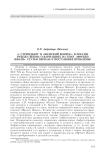
Статья научная
Первая и вторая статьи посвящены анализу роли творчества А. Стриндберга в дискуссии о «новой женщине» в России рубежа XIX-XX вв. В научной литературе был неоднократно отмечен интерес русских авторов этого периода к творчеству шведского писателя, однако в вопросе рецепции взглядов Стриндберга на женщину остаются неисследованные области. Обсуждение новой роли женщины в эпоху активных общественных изменений в России оказалось встречным течением, определившим особенное внимание к некоторым произведениям Стриндберга, в частности пьесе «Фрекен Жюли». В первой статье рассматриваются взгляды российских современников Стриндберга на изображение женщины в его творчестве и затрагивается история переводов и постановок «Фрекен Жюли» в России. Во второй статье мы обращаем внимание на влияние этой драмы на образы пьес «Вишневый сад» А.П. Чехова и «Жан Ермолаев» Г. Ге и концентрируемся на рассказе А.В. Амфитеатрова «Нелли Раинцева» (позднее превращенном автором в сценарий и Е. Бауэром - в фильм), сюжет которого, как впервые показано в статье, является вариацией сюжета стриндберговской «Фрекен Жюли». В качестве доказательств приводятся фрагменты дискуссии современников Амфитеатрова о женоненавистничестве Стриндберга, в частности письмо Горького к Амфитеатрову, и публицистические размышления самого Амфитеатрова о женских правах. Подвергаются анализу изменения, привнесенные Амфитеатровом в стриндберговский сюжет и характеры, и делается вывод о том, что Амфитеатров оправдывает «падшую» аристократку, в т.ч. путем предоставления слова ей самой с помощью дневниковой формы, нередко использовавшейся в то время в литературе и кино о новых женщинах. Делается вывод о том, как сюжет и характеры пьесы «Фрекен Жюли» были преобразованы в русской культуре.
Бесплатно

Aesthetic modernism as a macro-epoch. Part 1
Статья научная
I. A Systematic approach: The concept of “Modernism” in many European philological traditions has described and continues to describe an epoch around the year 1900 when writers and critics used the term with a reference to the “modern” literature of their time. The concept of a micro-epoch is determined by a beginning, an end, and a coherence of a given epoch, i.e. by means of an overriding programme in the literary field that remained dominant throughout the period described. Over approximately last fifty years, Western European philological traditions have developed a usage of the term that is unknown to Russian philology: as a macro-epochal concept, “modernism” describes a long-term period that begins with the first emergence of the concept of the modern (e.g. genius, autonomy, youth or publicity). Such a usage has continuously remained the focus of discourse - albeit with certain variations - and we still consider it to be important today in the context of the mindset of our present age. Thus, in contrast with pre-modern foreign concepts, the present defines the temporal continuum in which it finds itself and its own antecedent history. The historical perspective (II) demonstrates that the establishment of such a macro-epoch of modernism, including the antecedent history of its own consciousness of present, is by no means new. It could have emerged since late antiquity, which defined its own present with reference to a feeling of discontinuity in relation to Greek and Roman antiquity. Thus the classic dichotomy between antiquity and modernity arose, according to which “antiquus” meant pre-modern and old, and “modernus” meant contemporary and present. For the historian Cassiodor at the beginning of the 6th century, the decline of the old Western Roman empire brought about the beginning of a new age, which could only define itself in opposition to the old era. For Goethe, modernity began in the 16th century.
Бесплатно

Aesthetic modernism as a macro-epoch. Part 2
Статья научная
Our current concept of the modern generally stretches back to the epochal threshold around 1800. In political history, this break is marked by the French Revolution; in aesthetic history it is to be found at the end of early-modern Classicism in the “Querelle des Anciens et des Modernes” which led Schiller to his analysis of the contemporary mentality (“sentimental consciousness”) and Schlegel to a new guiding category in the realm of aesthetics (“the interesting” rather than the “beautiful”). This created an autonomy for modernism insofar as it defined itself with reference to the contemporary present and no longer on the basis of its relationship to the old pre-modern era. At the same time, the temporal horizon undergoes a shift: programmatic modern aesthetics understand themselves as a genetic principle that will only be redeemed in the future. There is nonetheless a deeply embedded oscillation in the modern, shifting between theory-constructing reflexivity and deconstructing reflexion. In literary artistic characters, the new self-image of the genius (as opposed to the old “poeta doctus”) is celebrated emphatically, whilst at the same time the possibility of this model being nothing more than an illusion of vain self-love is also postulated. Insofar as the typical modern reflexion of the reflexion repeatedly deconstructs its own constructions, modernism also wins a typically modern - which is to say “sentimental” - relationship to itself. Whilst the sciences free themselves completely from their obligation to older authorities and replace traditional practices with tradition-free experiential sciences based on empiricism and experiment, the relationship of aesthetic modernism to tradition is more complex. Premodern is the obligation to tradition; modern is the freedom to select a tradition which first manifests itself in the anti-classical counter-canon of the Sturm und Drang and Romanticism, thereafter in an entirely free playing field as far as references to tradition are concerned, developing into complicated forms of intertextuality.
Бесплатно

Статья научная
The author of the article proves that Pindar served as necessary source and model for the Alexandrian poets. It is not by chance that Callimachus refers to him in his most significant programmatic statements on poetry. It is no coincidence, either, that allusions to the fourth Pythian ode are also concentrated around the key moments of Apollonius’ narration (departure, meetings with the beloved, the hero’s trial, wedding and the poem’s ending). Pindar appears a source of the ideas for Callimachus anticipating his own notion of poetry. Callimachus, while formally opposing himself to the previous tradition, with the help of quotes and allusions constantly relies upon that very tradition; his picking up from it shows which ideas and images correspond to the main principles of Alexandrian poetics, Pindar plays here an important role. Apollonius considers Pindar among his major predecessors when recounting the story of the Argonauts. The poem of the Alexandrian poet and the fourth Pythian ode are obviously united by this topic. In the “Argonautica” there are lots of lexical parallels to Pindar. Pindaric expressions become the epic formulas in “Argonautica”. According to the author’s aim, Apollonius’ epic poem and the fourth Pythian ode could interact in the mind of the reader. They represent a certain unity, complementing each other. In this way, Pindar remains the major source uniting Callimachus and Apollonius, the poets traditionally opposed to each other.
Бесплатно

Статья научная
English-language reviews of translations of prose fiction are dominated by a “belletristic” approach whereby the artistic features of the translation text are assessed with little reference to its original. Such an approach fails to provide an adequate evaluation of the merits, drawbacks or “losses” in the translation under review. The author of the article offers a method of concrete comparative translation discourse analysis (CTDA) of originals and their translations based on their specific lexical, structural-communicative, stylistic, pragmatic, and sociocultural properties. At the lexical level, the objects of comparison of the original text and its translation are the following elements of denotative and connotative meaning: denotation - (1) denotative word-sense core; (2) denotative word-sense periphery; connotation - the “emotive charge” of the sense core, including (3) the nature of emotion and (4) its intensity; (5) the evaluative connotation of the word-sense (“the author’s attitude”); (6) functional style reference; (7) dialectal reference (temporal/generational, regional, and sociocultural); (8) comparative frequency of occurrence in a particular functional style; (9) word-sense pragmatics (word-sense comparative “metaphoricity,” its “political correctness,” “cumbersomeness” and some other features). At the predication level (sentence and clause), it is possible to single out 5-7 key (constant) syntactic and communicative “discrepancies” between Russian and English, which get rendered in either language with the help of 5-7 constant translation models. The assessment of the overall pragmatics of the translation text consists in determining the degrees of the neutralization, “domestication” (“naturalization”/localization), “contamination,” “foreignization,” and stylization of the original text. The comprehensive “impression” of the quality of a translation in the mind of the translation analyst, based on the analyses at the three levels (lexical, predication, and pragmatic), constitutes the tertium comparationis of the proposed analytical approach. Given the relative “fuzziness” and variance in individual perceptions of textual meaning, the categories of analysis and assessment proposed in this article are not absolute, belonging as they do to the qualitative methods of comparative translation studies. The article contains examples illustrating the author’s conceptual framework.
Бесплатно

Bakhtin reads Bryusov: salvation and creativity without a subject
Статья научная
Although Bryusov was not one of Bakhtin’s favorite writers, Bryusov’s reflection on the genre of the novel The Fiery Angel and general attention to the aesthetics of Russian Symbolism deepened the thought of early Bakhtin about the specificity of aesthetic experience, expressed in his Toward a Philosophy of the Act. For Bakhtin, Bryusov’s novel was an example of a winning rejection of the patterns of a historical and biographical novel in favor of a certain pose, and in contrast to the pose of Mayakovsky and other pop poets, which heightens attention to the middle state of the subject. In his work cited, Bakhtin puts the action as a value above the subject, while overcoming the theoretical implications of axiology and criticizing theoreticism, and here the description of the subject’s anomalies in the novel The Fiery Angel and a specific understanding of the suggestive word constructions in Bryusov’s article Keys of Secrets turned out to be in demand. Starting from the positions of Rickert and Simmel and changing the inner meaning of the key terms of these thinkers, Bakhtin took several terms from the works of Bryusov, which the commentators did not pay attention to. This was the term “cognitive activity” (uznanie), which meant participatory cognition, “obsession activity” (oderzhanie), meaning situational obsession, and some others, as a hidden dialogue with Bryusov. At the same time, Bakhtin disputed the concepts of obsession and the triumph of science promoted by Bryusov, covertly opposing the main concept of progress to the renewed Christology of Berdyaev and Rozanov. In this Christology, the subject in comparison with the deed may turn out to be completely useless, and here Bakhtin used Bryusov’s category of “uselessness of creativity” for interpretation of salvation not as useful, but as a necessary act.
Бесплатно

Статья научная
M. Petrosyan’s novel “The Gray House”, whose title is already a quote from the famous children’s poem (Russian: “Dom, v kotorom…”, literally: “The House, In Which...”), abounds with the quotes and reminiscences. The constantly arising quotes in the fiction world of the novel create a peculiar cultural code which is common for all main characters. Being socially isolated, the teenage characters create their special world filling it with the cultural senses. The understanding of the implication created by the references to other texts (it is generally rock music and fantasy or science fiction literature) allows the reader to join the fiction world of the novel too. The mention of rare, little-known texts becomes the sign of the author’s orientation to underground literature. A specific place among such texts is taken by Bob Dylan’s novel “Tarantula” published in Russian in 1991 The references to Bob Dylan’s “Tarantula” in M. Petrosyan’s novel “The Gray House” are present in the epigraphs to four chapters and the names of characters as well. In each case the separate words of their epigraph coincide with some element of the fiction world embodied in the chapter. The close link arises between the epigraph and the character who is a subject of consciousness and speech in the chapter. Nevertheless, the unambiguous semantic link of the epigraph with the text of the novel does not arise. It is explained by the specifics of the novel “Tarantula” where the author constantly appeals to the nonsense and absurdity. On the one hand, the senseless phrase taken as an epigraph hints at the existence of hardly perceptible and ambiguous sense. On the other hand, it calls into question reliability and unambiguity of the information received by our minds. Besides, the quotes from the same book create additional links between characters who are poorly connected at the plot level.
Бесплатно

Chronology of the English translations of Alexander Blok's works: history and modernity
Статья научная
The history of English translations of Alexander Blok’s poetry and prose (primarily the former, but interest in the latter is increasing nowadays) covers a lengthy and colourful period of nearly 100 years, beginning when the poet was still alive. In case with Blok’s works there are two main sources for translations into English: the first (and the richest) is represented by native English speakers (and among them are multitudinous professional literary workers, such as poets, literary journalists etc.) and the second relies on Russian immigrants (White émigrés and later) involved in the literary process, living in the UK, the US or elsewhere outside Russia. Although the first attempts at translating Blok’s poetry for the Western audience were not very successful, the actual work never fully died away, but rather diminished, for a variety of reasons (primarily non-literary). As a literary figure, Blok is not so vividly recognisable in the West as he might be: although his works are gloriously famous inside Russia, he is not a common subject for academic research. Partly, the problem lies inside the difficulty of translating his works, because they are complex, overpowered by the Symbolist philosophy and stylistically exquisite. But despite that, professional translators continue their efforts, and our main aim in this paper is to show the most significant of them, to systematise and to reveal which ones can be identified as the closest to the original, and widely quoted.
Бесплатно

Escapism and trauma in I. Babel's “Red cavalry”
Статья научная
The article presents an analysis of the narrator’s experience in “Red Cavalry”. The approach of the diegetic narrator to the reality of war is described as avoidance, or escapism. This approach is manifested in “Red Cavalry” on two levels: the diegetic level of “histoire” and the level of “narration”. Firstly, it is demonstrated in the article that the narrator wants to escape from the world of war on the diegetic level. Secondly, the reasons are discussed why his attempts to escape are never fully successful, or, in other words, eventful. A conclusion is made that one of the reasons might be the strong appeal, aesthetic and erotic, which the world of war has for the narrator. The narrator is described as painfully positioned between two “looming” events, that of a final escape and that of a transformation as a result of his collision with the world of war. After that, it is demonstrated that the experience of the narrator can be described as traumatic: firstly, because of the violence which permeates the world of “Red Cavalry”; secondly and most importantly, because one of the main features of trauma is its incomprehensibility, and the world is not comprehensible for the narrator. This incomprehensibility is rendered by the narrator both directly and through form. Namely, by way of ellipsis, when the narrator avoids speaking directly about what disturbs him (but it nevertheless “shows itself through” the narrative), and also through the way Babel’ uses “telegraph” style when speaking about violence, thereby avoiding conceptualization. Finally, the connection is shown between the two key concepts of the articles, escapism and trauma: the escapism of the narrator is seen as a reaction to the traumatizing reality, and the narrator’s inclination to avoid conceptualization is interpreted as a gesture of escapism.
Бесплатно
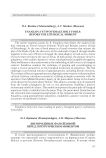
Fanailova’s two female holy fools: before the liturgical moment
Статья научная
The article examines poems by E. Fanailova that depict the modern holy fool, drawing on French sources (Simone Weil) and Russian sources (Xenia of Petersburg). At the core of both poems is a literal inversion that mirrors the plot of the Book of Job: the discovery of the underside of speech through double negation in the case of Weil, or through the total allegory of God as the creator of text-texture-sewing in the case of Xenia. In both poems, the primary device is polyphony, with various characters’ voices, simultaneously incapable of negation. Holy foolishness is thus understood as the embedding of Job’s story in a liturgical context: Fanailova employs the technique of peeping and eavesdropping to create a reverse perspective on the liturgical institution of polyphony. The fool challenges conventional notions of appropriateness, including literary decorum. The critique of literary appropriateness, aligning in some respects with postmodern cultural criticism, introduces persistent stylizing strategies consistent with the narrative: from Mikhail Kuzmin’s legacy in the poem about Xenia to the theater of the absurd in the poem about Simone. This adopts a strategy of style separated from the female protagonist by one or two generations, enabling a positive stereoscopic model of culture. This model incorporates the principles of liturgical sequences, litany, or akathist into the poem. Thus, the poem about Xenia discerns the structural and compositional principles of the troparion and the synaxarion. Fanailova, using postmodernist polyphony, establishes a positive concept of the occurrence of sainthood in history.
Бесплатно

Статья научная
The article presents a brief comparative study of two epistemologically different approaches to the problem of poetic rhythm whose authors, paradoxically, have much in common. Both of them were born in 1932, in families originated, respectively, from the region of Bessarabia and Romania, became university professors and contributed a lot to reform the methodology of literary analysis, with particular interest to the questions of poetic rhythm, studied Bible texts from the poetic viewpoint, inherited from Russian Formalists, paid special attention to such aspects of literary works which could be investigated only through oral performance, and, nevertheless, have developed two almost opposite visions of poetry and literature as a verbal art. In our study, we aim to reconstruct the main conceptual and methodological assumptions of their theories in order to explain the reasons of such unexpected final divergence and, probably, outline ways to synthesize their approaches. Our hypothesis consists to see in Henri Meschonnic’s “historical anthropology of language” and Reuven Tsur’s “cognitive poetics” two radically different, but not incompatible, visions of “literary fact”, respectively, from the viewpoint of humanities and natural sciences.
Бесплатно
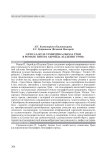
Genius loci и семиотика образа трои в романе Питера Акройда "Падение Трои"
Статья научная
Роман П. Акройда «Падение Трои» соединяет мифологизированную историю и реальность исторического факта, сплетая в единстве персонажно-образной системы биографии исторически достоверных, известных персонажей с образами художественными, вымышленными (Генрих Шлиман / Генрих Обреманн). Сопряжение мифа и реальности определяет своеобразие спациопо-этики произведения, в котором важное значение приобретает концепт Genius loci (гений места), представляющий не только мифопоэтику романа в целом (Троя - город Зевса, Афины, Гектора, Андромахи), но и своеобразие входящих в нее локусов, связанных с легендарным и реальным, древним и вписывающимся в современность городом: Троя - это легендарный, воспетый Гомером и вместе с тем реальный, имеющий точные географические координаты город в Малой Азии, утраченный и вновь открытый Г. Шлиманом (Троя / Илион / Гиссарлык). Немаловажную роль при создании образа Трои играет палимпсестность города, связанная с историей его возникновения, в связи с чем акцентируется исторически сложившаяся многоуровневость, многослойность Трои. Своеобразие возникающей в романе городской мифологии определяет «Genius loci» - концепт, сохраняющий исконное значение и вместе с тем изменяющийся, приобретающий разнообразные проекции смыслов под влиянием символического «осложнения» (усложнения) изображаемой городской реальности, ее «семиотизации». Рассмотрение поэтики романа Акройда в этом ракурсе и определило исследовательскую задачу и содержание статьи, представляющей Трою и ее Genius loci как семиотический, художественно емкий образ с характерной постмодернистской взаимообратимостью реальности, мифа и истории.
Бесплатно
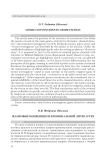
Genre conventions in crime fiction
Статья научная
The article raises the question of the existence of conventions that define the poetics of each of the main genres of detective literature: classical detective, “adventurous investigation” (in N.N. Kirilenko terms), police novel, and “victim investigation” (as described by the author of the article). Unlike the established tradition of highlighting the rules for writing an abstract “detective story”, it is proposed to turn to the system of criminal genres, denoted with reference to Mikhail Bakhtin’s three-dimensional model. Based on this, several genre conventions are highlighted, which, consciously or not, are adhered to by both authors and readers. At the heart of their differentiation lies the perception of the game, forming its own kind of poles in the system of criminal literature: the gaming relationships between the detective, the criminal, and the representatives of official authorities in the classical detective and “adventurous investigation” stand in stark contrast to the purely negative game of the criminal with the victim and / or detective in the police novel and “victim investigation”. Other important genre conventions are also considered: the essential infallibility of the Great Detective in the classical detective, which, on the contrary, is not relevant to “adventurous investigation”; the team investigation of professionals in the police novel, and the forced investigation conducted by the victim to save their own life. The final conclusions: each of the criminal genres embodies its specific convention upon which works and their reception by readers are constructed; the violation of such a convention blurs the boundaries of the genre and can be a form of authorial play.
Бесплатно
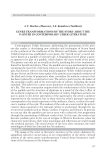
Genre transformations of the story about the painter in contemporary Uzbek literature
Статья научная
Contemporary Uzbek literature, addressing the perceptions of the present-day reader, is developing new attitudes and techniques of fiction based on the synthesis of the traditions of the Western and Islamic cultural worlds. Uzbek literature has established a new genre, the “ma’rifi novel”, a novel narrative based on a parable of oriental type. A biographical novel about a painter appears to be part of a parable, which depicts the inner world of the artist. The painter can only act as socially active by justifying his or her treatment of himself or herself and others. Thus, the parable serves as a mechanism for mainstreaming the inner life of the hero when it is not embedded in a melodramatic plot, but directly refers to the final moral judgment. While Uzbek literature of the pre-Soviet and Soviet times spoke of the painter as an inspired conductor of the ideal and carrier of progressive ideas, nowadays the mimetic concept of art has been replaced by a constructive one. The artist is portrayed as the maker of the secondary reality and of the universal code of culture, including the moral standard. This allows for a more acute depiction of moral collisions in the artist’s life. This new conception requires both the reinforcement of the features of the parable and the insertion of ekphrasis as a model of the direct effect of the aesthetic program on the comprehension of reality. Ekphrasis permits not just to point to the direct perception of the painting by the artist’s audience represented in the narrative, but to show that the artist’s personal experience corresponds to the social experience of the audience, that is, to show the audience’s readout of the code. The readout of the code as a sum total of the artist’s creative ideas essential to the national culture is accelerated through the use of universal symbols such as Home, Garden, Creation, and History. In general, we can say that the parable turns into a story with a relatively free progression through the mentioning of different works of art. In this case, the works of art become symbols, quite in the vein of intrigue in Western literatures, when the characters’ motivations, their inner monologue and reflections are read through the artificial pictures. The moral choice of the hero then continues the inner monologues of both her/him and her/his audience.
Бесплатно

Heterotopy of the country estate in the poetics of Russian symbolism (part I: Zinaida Hippius)
Статья научная
The article describes the phenomenon of describing a country estate in the literature of Russian modernism as a heterotopy. The estate narrative of Russian literature of the 19th century demonstrates that the most significant events in the hero’s life take place in the noble estate, and consequently, the duration of the action and the plot are maximally compressed, and at the same time extended in time. We should not forget that in fact the noble estate served as a repository of intellectual and cultural memory. After the destruction of the landowner estate in Soviet times, the most important signs of the manor heterotopy are preserved: this is the memory of a geographical place, a memory of the manor topos. The heterotopic model of the Russian estate demonstrated exceptional stability for a long time, having functionally transformed, on the one hand, into a summer residence (dacha); on the other hand, the function of the cultural memory is taken over by the modern museum-estate. The article analyzes the stories of Zinaida Hippius “The Witch”, “Two - One”, “Out of Time”. The manor space of Hippius stories not only creates scenery for the storyline, but also reflects the natural world bursting into the hero’s mind, that conflicts with the rational-conceptual line of urban behavior. Elements of the folklore-mythological narrative characteristic of the aesthetics of Russian symbolism are revealed (the story “The Witch”). At the heart of the semiosphere of the country estate’s world of Hippius stories is the Turgenev’s plot of a summer romance flirt. Contact with the elements of nature is not only a triumph of the irrational and mystical in the hero’s mind, but also signs of his initiation: thus, the story “Two - one” is devoted to the topic of the physiological maturation of the hero, who overcomes the boundary between the memory of the manor paradise of his childhood and growing up. In one of Gippius’ later stories, the world of country estate culture turns into a fantastic and closed world where time flows according to its own laws, and the manor with its old library becomes a repository of the cultural memory of a passing era (“Out of Time”). The semiosphere of the homestead world in Hippius stories demonstrates the hero’s movement to a functionally different space compared to his usual world, where real events can receive a fantastic explanation (“The Witch”), and time flows according to its own laws, turning out to be a frozen capsule of time (“Out of Time”). Actual events occur both in a metaphorical (memory and living memory) and mythological (false synchronization) time section (the stories “Out of Time” and “Two - One”); the movement of historical time itself is extremely slow and completely freezes (“Out of Time”)
Бесплатно
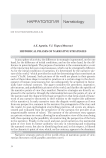
Historical phases of narrative strategies
Статья научная
In any sphere of activity, the difference in strategies is generated, on the one hand, by the difference of initial conditions, and on the other hand, by the difference in potential goals. The purpose of narration is the communicative event of the interaction between consciousnesses, which can be strategically different. As for the initial conditions of narration, it’s determined by the narrative picture of the world, “which provides the scale for determining what constitutes an event” (Yu.M. Lotman). Such pictures of the world are phasic in their genesis: each of them takes shape in narrative practices at a certain stage in the development of human consciousness but can subsequently be actualized in historically later cultural contexts. The paper considers the precedent, imperative, adventurous, and probabilistic pictures of the world, and clarifies the specifics of the narrative points of view they manifest. Narrative strategies are directly expressed in the narrative through the relationship between the points of view of the narrator and the character (the basic perspectives that form a kind of framework of any narrative discourse) in their relation to the reader (the addressee of the narrative). In early narrative texts the diegetic world appears as if seen from one perspective, common to the narrator, the protagonists of the story and the reader. In post-mythological storytelling practices, all events are demonstrated and evaluated from the perspective of the narrator, the provider of an unquestionable system of values. The narrator of the adventure story appears as a private witness to events, allowing for an alternative view of the story being told, thus opening up the possibility of constructing the perspective of the hero in the narrative. Finally, in the novel and post-novel narratives, the narratorial point of view loses its former authority not only in witnessing and evaluating the narrated events, but also in identifying them and, in this respect, is likened to the character’s point of view, which, on the contrary, appears to be dominant.
Бесплатно

Статья научная
Владимир Аристов - поэт русскоязычного метареализма, литературной школы, поиски которой находятся в области поэтической метафизики и усложнения семантики словесного образа. Осмысляя переходный период русской культуры и общества в 80-е годы XX века, он пишет цикл «Реализации», состоящий из трех поэм («Дельфинарий», «Кинорежиссер», «Омега моря») и двух стихотворений («Балтийские отражения» и «Пробуждение»). В поэме «Дельфинарий» поэт выражает поиски «пространства всеобщей родственности» и общего языка, общей телесности. Свою работу в этом ключе В. Аристов обозначает понятием «idem-forma», которое означает и особую технику создания стихотворений, и метод анализа художественных текстов. Данное понятие коррелирует с понятием «метабола», введенным М.Н. Эпштейном для анализа образной структуры и поэтического языка метареализма. В поэтике В. Аристова метабола является одним из элементов idem-form'ы, выражающим отношения синкретизма, синтеза и тождества на тропеическом уровне. Несмотря на то что термин «idem-forma» был предложен поэтом только в начале XXI века, образная структура анализируемой поэмы «Дельфинарий» говорит о том, что творческие поиски в этом русле В. Аристов ведет на протяжении всего литературного пути. Специфическими чертами использования этой техники в поэме является синтез на уровнях хронотопа и фокализации, субъектный неосинкретизм и образы-метаболы, выражающие и пересемантизацию деталей советского быта, и синтез миров - человеческого и природного, телесного и языкового. В данной статье анализируются I и II части поэмы «Дельфинарий».
Бесплатно

Impact potential of political internet-memes: Yu.V. Rozhdestvenskiy's theory of rhetoric
Статья научная
The article examines communicative features of political Internet-memes, their rhetorical nature and considers them as a new genre of political Internet-communication. The research advances the framework of Yuriy V. Rozhdestvenskiy’s theory of rhetoric to apply it to genre specification of Internet-memes with the focus on political communication. The method of rhetorical analysis helps to uncover the manipulative potential of political Internet-memes and views such communication as an integral complex framework from the author’s intention regarding the speech act to the final influence on the target audience. Political Internet-meme is considered through the prism of the following parameters: (1) Ethos (i.e., contextual aspect): a) Status-role characteristics of the parties (the author, the distance, topic relevance), b) Type of communication, c) Theme; (2) Pathos: Intention, (2.1) Pathos - Ethos: a) Type of argumentation, b) Evaluating (evaluative point of view); (3) Logos: (3.1) Ethos - Logos: Author’s image of the genre, (3.2) Pathos - Logos: Textual aspect (topic elaboration, argumentation, style, composition etc.). The research outlines and describes features that characterize the structure of the political Internet meme ethos, pathos and logos as well as their inter-determination, thus making the Internet meme a powerful tool of public opinion management. Being a product of political public relations, political meme becomes a phenomenon of digital mass culture.
Бесплатно

Improvisation as a readerly response in avant-garde poetic practices (group “41°”)
Статья научная
The paper focuses on the poetic activities of “41°” circle (A. Kruchennykh, I. Zdanevich, I. Terent’ev). Communicative interactions between the author and the reader take center stage. Russian Avant-garde communities are considered to mobilize the creativity of a reader, to turn the reader into a co-author (see Ioffe, Bobrinskaya, Feshchenko), and, as a community, “41°” was no exception to the rule. In the community of “41°,” a particular readerly response (W. Iser) becomes prominent and is foregrounded: an active improvisation on the part of the reader. The author casts himself as a pedagogic persona initiating the contact with the reader, yet it does not appear to be the case that he aspires to take on the role of a poetic authority. Rather, the poet invites the reader to engage with the poetic text, so that the latter is able to actively re-write the text, tp re-create it and to use the text as a foundation for improvisation. Improvisation as a readerly response is analyzed in three communicative interactions involving the presence of three types of readers, the readers being the actual reader, the actual reader aspiring to fill in the role of an ideal reader, the implied reader. In all three cases improvisation is projected as a readerly response. The possibility of such a response is closely linked to an emphasis on marginal, epiphenomenal characteristics of the poetic utterance. This implies an emphasis on the look of the word (font choices, letter size, the combination of these parameters in a word), aspects of poetic performance (the way the text is articulated). These characteristics are considered to be particularly expressive, emotionally charged, so that the experience they convey lays the foundation for the improvisation on the part of the reader.
Бесплатно

